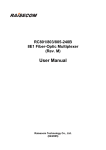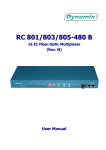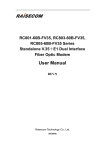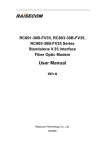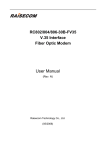Download Raisecom RC803 User manual
Transcript
RC801/803/805-120B 4E1 Fiber-Optic Multiplexer User Manual Raisecom Technology Co., Ltd. (04/2005) Raisecom Technology Co., Ltd 1. Cautions Please read the following notices carefully before installing and using the device, Raisecom does not respond to any loss that caused by violating safety notice. RC800-120B series optical multiplexer provides two types of power supply: AC and DC. When using DC power supply, please plug the power supply connectors according to this mannual strictly and avoid contrary connecting. RC800-120B series fiber-optic multiplexer is integrated device that has precise elements, please avoid violent shakes and impacts, and do not disassemble or maintain the device yourself. If it is required, please do it under the guide of our technical staff following in the steps of anti static. Please contact us if there is any need. There must be grounding protection for the sake of safety; do not disassemble the device yourself, we regard it as you waiver your rights of repair guarantee. 1 Raisecom Technology Co., Ltd Contents 1. Cautions ...........................................................................................................................................1 2. Overview ..........................................................................................................................................3 3. 4. 2.1. Introduction ..............................................................................................................................3 2.2. Product Features......................................................................................................................3 2.3. Part Number Introduction .........................................................................................................3 2.4. Dimensions ..............................................................................................................................4 Parameters.......................................................................................................................................5 3.1. E1 Interface Parameters ..........................................................................................................5 3.2. Optical interface characteristic .................................................................................................5 3.3. Power Supply ...........................................................................................................................5 3.4. Ambience .................................................................................................................................5 How to use .......................................................................................................................................6 4.1. Introduction of the Front Panel ...............................................................................................6 4.1.1. Power indicator ................................................................................................................6 4.1.2. Alarm indicators ...............................................................................................................6 4.1.3. DIP-switch SW1 Setup: All OFF by Default .....................................................................6 4.1.4. DIP-switch SW2 Setup: All OFF by Default .....................................................................8 4.1.5. Function Buttons: All “High Position” by Default ..............................................................8 4.1.6. Network Management Port ..............................................................................................8 4.2. Introduction of the Rear Panel .................................................................................................8 4.2.1. Power Switch ...................................................................................................................8 4.2.2. Power Socket...................................................................................................................9 4.2.3. Optical Port ......................................................................................................................9 4.2.4. E1 Interface .....................................................................................................................9 4.3. 5. DIP-switch on the Bottom Panel ..............................................................................................9 Installation and Test .......................................................................................................................10 5.1. Inspect after Opening.............................................................................................................10 5.2. Preparation before Installation ...............................................................................................10 5.3. Installation Procedure ............................................................................................................10 5.3.1. Connecting Cables.........................................................................................................10 5.3.2. Applying the Power Supply ............................................................................................10 5.3.3. Configuring Buttons and Switches .................................................................................11 6. Troubleshooting .............................................................................................................................12 7. Appendix A Introduction of Cable Making ......................................................................................14 A.1 E1 Cable ......................................................................................................................................14 A.2 Computer Serial Cable Making ....................................................................................................14 2 Raisecom Technology Co., Ltd 2. Overview 2.1. Introduction RC801/803/805-120B series fiber-optic multiplexers are ideal fiber-optic transmission devices for point-to-point networks, medium-sized and small capacity networks, such as wireless communication base stations, private communication networks, and switches organizing networks. The transmission capacity of RC800-120B is 4 E1 channels (equivalent to 120 voice channels). 2.2. Product Features • • • • Very large scale ASIC chips ensure low power consumption; 4-layer PCB ensures high reliability Complete alarm indication that can display local and remote alarms simultaneously Alarm lock and E1 channel loop back detection capabilities provide convenient debug methods. Capable of local and remote network management, providing 4-bit cascading address DIP switches 2.3. Part Number Introduction Example: RC 801 – 120 B / AC AC power supply Version 4 E1 channels, equivalent to 120 voice channels Standalone dual-strand fiber-optic multiplexer Company code (short for Raisecom) First section head: RC —— short form of Raisecom First section end: 801 —— standalone dual-strand fiber-optic multiplexer 803 —— standalone 1310 TX wavelength single strand fiber-optic multiplexer 805 —— standalone 1550 TX wavelength single strand fiber-optic multiplexer Second section head: 120 —— 4 E1 channels, equivalent to 120 voice channels Second section end: B —— version B Suffix: AC ——AC 220V power supply 3 Raisecom Technology Co., Ltd DC —— DC -48V power supply Note: RC801 standalone fiber-optic multiplexer shall work in pairs RC803 and RC805 must cooperate in pairs. One RC803 must work with one RC805. 2.4. Dimensions Compact 19-inch standard 1U-high chassis, 440mm (W) x 43.6mm (H) x 180mm (D) 4 Raisecom Technology Co., Ltd 3. Parameters 3.1. E1 Interface Parameters Bit rate: Line code: Impedance of interface: Electrical characteristics: Transfer characteristics: Input jitter tolerance: 2048Kbps±50ppm HDB3 75Ω (unbalanced) or 120Ω (balanced) complies with ITU-T G.703 complies with ITU-T G.823 complies with ITU-T G.823 3.2. Optical interface characteristic Bit rate: Line code: Fiber connector: 100Mbps 4B5B SC Part Number Connector Type Wavelength (nm) Launch Power (dBmW) Receiving Sensitivity (dBmW) Over load point (dBmW) Transmission Distance (Km) Link Loss (dB/Km) RC801-120B-S1 RC801-120B-S2 RC801-120B-S3 RC803-120B-S1 RC803-120B-S2 RC805-120B-S1 RC805-120B-S2 DSC DSC DSC SC/PC SC/PC SC/PC SC/PC 1310 1310 1550/DFB 1310 1310 1550 1550 -15 ~ -8 -5 ~ 0 -5 ~ 0 -12~-3 -5 ~ 0 -12~-3 -5 ~ 0 < -34 < -34 < -36 < -30 < -32 < -30 < -32 -8 -8 -10 -8 -8 -8 -8 0 ~ 25 10 ~ 60 15 ~ 120 0 ~ 25 10 ~ 50 0 ~ 25 10 ~ 50 0.5 0.5 0.25 0.5 0.5 0.5 0.5 3.3. Power Supply DC: -48V, range from -36V to -72V AC: 220V, range from 165V to 265V Power consumption: ≤10W 3.4. Ambience Working temperature: 0 ~ 45℃ Relative humidity: ≤90% (25℃) 5 Raisecom Technology Co., Ltd 4. How to use 4.1. Introduction of the Front Panel GL Power OFF Alarm of Fiber LOS on E1 Dip-switch ON 12 3 4Interface 56 NM Function Button Figure1: Sketch of the front panel of RC800-120B 4.1.1. Power indicator PWR (green): On, power supply is functioning normally. 4.1.2. Alarm indicators Alarm indicators of both local and remote side can be displayed. The L row indicates “local”. The R row indicates “Remote”. • General alarm: GL general alarm indicator (red): Any generated alarm will make GL indicator “on”. • LOS for E1 link LOS1~4 E1 link (red): when there is signal loss of any E1 channel, the relative alarm indicator turns red. z Alarm of optical port: LOS loss of signal (red): When receiving signals are lost, the alarm indicator turns on. LOF loss of frame (red): When optical receiving frames lose synchronization, the alarm indicator turns on. E-3 bit error alarm (red): ON, when the receiving bit error rate exceeds 10-3. E-6 bit error alarm (yellow): ON, when the receiving bit error rate exceeds 10-6. 4.1.3. DIP-switch SW1 Setup: All OFF by Default DIP-Switch SW1 on the front panel is used for setting loop-back detection and saving the configurations • 1st ~ 4th: Loop-back 1st bit 2nd bit 3rd bit 4th bit 6 Loop-back Raisecom Technology Co., Ltd OFF OFF OFF OFF No loop-back OFF OFF OFF ON 1st E1 OFF OFF ON OFF 2nd E1 OFF OFF ON ON 3rd E1 OFF ON OFF OFF 4th E1 ON ON ON ON All E1 links Note: Only two test method can be set: single E1 channel loop-back or all E1 channels loop-back. When single E1 channel loop-back is testing, the other channels work normally. • 5th bit: loop-back type options This switch is used to choose “remote loop-back” or “local loop-back” when performing the E1 loop-back operations. 5th bit Loop-back type option OFF Remote loop-back enable ON Local loop-back enable Fiber BER tester Multipl exer Multipl exer E1 E1 Local Remote Figure2: sketch map of setting remote loop-back on local site Fiber BER tester Multipl exer Multipl exer E1 E1 Local Remote Figure3: sketch map of setting local loop-back on local site Note: When any loop-back is set on local site, 1st ~ 4th loop- back DIP-switch of remote site must be all off (not loop-back). • 6th bit: Saving the configurations OFF: when rebooted, the equipment will read from the saved configurations. ON: when rebooted, the equipment will not read from the saved configurations. 6th bit Switch for saving configurations OFF Read from the saved configurations when booting ON Not read from the saved configurations when booting 7 Raisecom Technology Co., Ltd 4.1.4. DIP-switch SW2 Setup: All OFF by Default SW2 is the switch for address code setting. When all OFF, the equipment can be remote managed; otherwise, it can be managed locally through LNK-UP port. The addresses shall not be the same for the equipment cascaded at OFF one serial port. There are 4 bits of this switch, so that the max number ON 1234 of local cascade equipment is 15. 4.1.5. Function Buttons: All “High Position” by Default • GL LCK / GL CLR Global alarm lock/ Global alarm clear button: When button is “low”, the GL is on Global alarm lock mode. The GL indicator will not off once turned on until alarms are cleared. When button is “high”, the GL is on Global alarm clear mode. • MASK / NO MASK “Low”: Mask unused E1’s alarm “High”: Not mask unused E1’s alarm • EN RING / DIS RING Alarm ring enable/disable button “Low”: Enable alarm ring. When there is alarm, the “zi…zi…” alarm rings. “High”: Disable alarm ring, but the service phone still rings. • CALL Service phone button “Low”: the “di…di…” rings at the remote-site equipment “High”: the ring off at the remote site 4.1.6. Network Management Port • LNK-UP shall be connected to the serial port of computer or LNK-DWN port of up-level equipment when cascading • LNK-DWN shall be connected to low-level equipment LNK-UP port Please refer to Appendix A.2 for the sequence of serial cable between LNK-UP and computer serial port. Please use RJ45-RJ45 straight-through cable to connect LNK-DWN and LNK-UP ports. 4.2. Introduction of the Rear Panel Figure 4. RC800-120B standalone PDH multiplexer 4.2.1. Power Switch This switch is used to turn on/off the power supply. 8 Raisecom Technology Co., Ltd 4.2.2. Power Socket AC: 220V standard triple-phase power socket DC: -48V power interface. Left pin for -48V, right pin for 0, and the middle pin for ground 4.2.3. Optical Port • The fiber connector is DSC/PC for dual-strand models, TX for signal output and RX for signal input The fiber connector is SC/PC for single strand models. • 4.2.4. E1 Interface There are 4 groups of E1 interface. Each provides 2 BNC coaxial ports and 1 RJ45 port. Refer to Appendix A for cable making. • BNC for 75 Ohm unbalanced signal. OUT for output and IN for input • RJ45 for 120 Ohm balanced signal. 4.3. DIP-switch on the Bottom Panel The DIP-switch can be set by small flat screw-driver. Each group of dip-switch corresponds to one E1 interface. ON Definition as shown below st nd rd OFF th st rd 1234 1 2 3 4 1 2 3 4th ON ON ON OFF Or OFF OFF OFF ON 75Ω unbalanced signal effective 120Ω balanced signal effective As shown in figure above, the default status is set as “75Ω unbalanced signal BNC interface effective”. It is suggested that users should use BNC connector for 75 Ohm unbalanced signal and RJ45 connector for 120 Ohm balanced signal. 9 nd Raisecom Technology Co., Ltd 5. Installation and Test 5.1. Inspect after Opening Please first check if the models and part numbers are in consistence, and also check if the equipments are damaged. 5.2. Preparation before Installation z z z z z z Carefully read this manual Prepare all kinds of the cable. Ensure that they are not short-circuited. Refer to Appendix A for cable making. Ensure the pressure of power supply is in the tolerance range, the chassis is well connected with the ground. Prepare the BERT and optical power meter for test of line quality. Change the dip-switch setting on the bottom panel if 120 Ohm balanced signal interface is required. Fix the equipment on to 19-inch rack or place the equipment at stable and secure environment. Pay attention to the requirements of the ambience. 5.3. Installation Procedure 5.3.1. Connecting Cables z E1 port It is suggested that users use SYV75-5, SYV75-3, and SYV75-2-2 coaxial cables to connect the BNC connector. And use twisted-pair to connect the RJ45 connector. z Optical interface Plug the SC fiber tail into optical interface (push hard until to the deep end). If not sure about transmission direction, it’s advised first to turn on the power of device and then plug in the fiber cable. 5.3.2. Applying the Power Supply If power supply (PS) is DC –48V, first connect middle end to PGND. Turn off PS, connect “-48V” end with the lower electric level cable, “0V” end with higher electric level cable. Make sure no reverse connection, or no short circuited, and then turn on power. If PS is AC 220V, use the PS line in the accessories. When PS is turned on, the PWR indicator should be on. 10 Raisecom Technology Co., Ltd 5.3.3. Configuring Buttons and Switches After turning on power of the device, first ensure there is no alarm on optical port. If optical ports are connected properly, there shall be no LOS, LOF, and E-3 alarm. The E-6 (yellow) may be on the moment when the power is just turned on. This is because turning on the power causes jitters which results in a few bit errors. After 10 seconds, E-6 will be off. This indicator refreshes in every 10 seconds. z Bit error rate test Using 2M bit error tester as well as loop-back switch of front panel can test the bit error level of E1 channel. Refer to Chapter 4. z Mask unused E1 channel alarm If the connected E1 links are working in good condition without any signal loss, while there is still another unused E1 link, the LOS alarm for unused E1 link may occur, which is called “unused E1 alarm”. Press MASK/NO MASK button “on” to clear all the unused E1 alarm and all the E1 LOS alarm indicators will be off. In the case unused E1 link alarm being masked, if the connected E1 sub-channel is disconnected, the LOS indicator of this sub-channel will still be on. If power supply is cut off and turned on again, then the mask function will be disabled. Press button to “off” and then pressed to “on” again. If after a period of operation, a new E1channel is needed, first disable the mask function and then connect E1 link. z Turn on the alarm ring Press the button “ON” of EN RING / DIS RING to make alarm ring available. In this time, if there is any one alarm indicator on, it will ring like “ZI…ZI…”. z GL alarm indicator lock (optional) When there is no alarm indicator on, press GL LCK / GL CLR to “ON”, global alarm lock function is configured as enable. If there is any alarm, then the global alarm indicator will keep on. When all other alarm are eliminated, press the button of GL LCK / GL CLR to “OFF” to clear the GL alarm indicator When the GL LCK / GL CLR button is “OFF”, also called real time display, i.e. if there is other alarm, the global alarm is on; if there is no other alarm, the global alarm is off. In the unstable voltage environment, there are often instantaneous alarms for voltage waving. In this environment, it is not suitable for operating the GL alarm lock function. 11 Raisecom Technology Co., Ltd 6. Troubleshooting If there are any problems during installation and using, try the following proposals. If the problems still can not be solved, please contact distributors/agents for help. The following explanations and solutions for alarms at optical ports and LOS alarms at E1 ports are used to handling local alarm problems. For remote-end alarms, please handle them at remote site. z Green PWR indicator not on Answer: PS faults. Check whether PS is working properly and –48 PS connection is not reversed. z GL global alarm red indicator on Answer: there are three different cases. 1. If there are other alarms on, please solve corresponding problem and then clear GL. 2. If there is no other alarm indicators but only GL alarm on and GL LCK button is on. This means there was once other alarm on, in this case can clear GL alarm. 3. If all other alarms are “OFF” and the GL LCK button is also “OFF”, but GL alarm indicator still flash or on and there is a HDB3 coding violation alarm in E1 receiving signals. There is problem that E1 link is too long to bring too much disturbance, so the signal attenuation is beyond –6dB. We can test the level of bit rate when this E1 link connecting with RC801-480B. z LOS red indicator of optical port is on Answer: Loss of receiving signal occurs at optical port. Check whether the input fiber (RX) is connected well and ensure not reversed. Or check the receiving optical power with optical power test-meter; it should be greater than receiving sensitivity specification. z LOF red indicator of optical port is on Answer: Loss of frame synchronization of receiving signal at optical port. In this case, optical signal has been received, but the optical power may be near threshold value of sensitivity. Check RX optical power and ensure whether the sending optical port (TX) of remote-site is connected. z E-3 red indicator is on at optical port Answer: The bit error of optical RX signal is greater than 10-3. Check if optical RX port connects well and RX optical power. z E-6 yellow indicator of optical port is on Answer: The bit error of optical RX signal is greater than 10-6. It is normal that E-6 alarm occurs for 10 seconds just after turning on the power, after 10 seconds the E-6 indicator will be off. If E-6 alarm occurs during operation, check whether optical RX port connects well and RX optical power. 12 Raisecom Technology Co., Ltd z LOS red indicator of E1 sub-channel is on Answer: Loss alarm of RX signal at E1 sub-channel, no HDB3 signal is received. Check whether all E1 ports are connected well, or whether 75 Ω cables are reversely connected, or whether the wires of 75 Ω cables are in right order. If LOS alarm occurs at unused E1 sub-channel, press “mask” button to “on” to musk the alarm after finishing the configuration of device. z Mask button is on, but there is still alarm in unused E1 sub-channel. Answer: probably the mask function is disabled if power supply is cut off and then turned on. To solve is by pressing the mask button to “OFF”, and then pressing to “on” to enable mask function. 13 Raisecom Technology Co., Ltd 7. Appendix A Introduction of Cable Making A.1 E1 Cable 75 Ohm BNC connector: SYV 75-5, SYV 75-3, or SYV 75-2-2 coax cable,the distance shall not be longer than 200m. First pick out the BNC connector from the accessories, and release the tail protecting jack. Secondly, separate the core from the shield, and put the tail protecting jack on it. Solder the strand with the core of the BNC connector. Solder the cable shield with the shield of the BNC connector. Finally, fix the jack at the end of the connector. 120 Ohm RJ45 connector: It is suggested that connect with unshielded twisted pair RJ45 connector (BALANCE), 1 to 8 pin from left to right be defined as following: 1——OUT+ output+ 2——OUT- output- 5——IN+ input+ 6——IN- input- Others——GPND A.2 Computer Serial Cable Making Computer serial port LNK-UP adopts RJ45 connector. The definition of pins: 3 ——RXD 232 signal input 7 ——TXD 232 signal output 4, 8 ——GND Others——hang on The sequence of the cable for connection between LNK-UP port (RJ45) and computer serial port (DB9 female connector) is as follows. RJ45 DB9F 3 ←— 3 7 —→ 2 4, 8 —— 5 z 14 Raisecom Technology Co., Ltd @2005 Raisecom Technology Co., Ltd. All trademarks are the property of their respective owners. Technical information may be subject to change without prior notification. 15
















